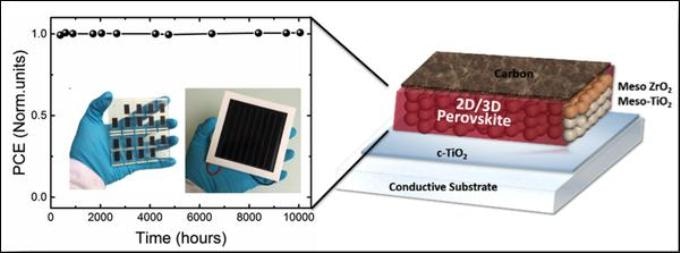Jun 2 2017
EPFL Researchers have constructed an economical and ultra-stable perovskite solar cell that has been operating at 11.2% efficiency for more than a year, without loss in performance.
 This is a schematic representation of the findings of this study. (Credit: MK Nazeeruddin/EPFL)
This is a schematic representation of the findings of this study. (Credit: MK Nazeeruddin/EPFL)
Perovskite solar cells assure cheaper and efficient solar energy, with huge prospects for commercialization. But even though they have been proven to accomplish more than 22% power-conversion efficiency, their operational stability still fails market requirements. Despite many projected solutions in fabrication technology, this problem has continued to undercut whatever incremental increases in efficiency have been achieved. EPFL Researchers have currently built an economical, ultra-stable perovskite solar cell that has functioned for over a year without loss in performance (11.2%). The research details have been published in Nature Communications.
The laboratory of Mohammad Khaja Nazeeruddin at EPFL, in partnership with Michael Grätzel and Solaronix, has designed what is known as a 2D/3D hybrid perovskite solar cell. This integrates the improved stability of 2D perovskites with 3D forms, which efficiently absorb light across the whole visible spectrum and convey electrical charges. In this way, the Researchers were able to produce efficient and ultra-stable solar cells, which is an essential step for upscaling to a commercial level. The 2D/3D perovskite yields efficiencies of 14.6% (standard mesoporous solar cells), and 12.9% (carbon-based architecture).
The Researchers constructed 10 x10 cm2 solar panels using a completely printable industrial-scale process. The resulting solar cells have now supplied a constant 11.2% efficiency for over 10,000 hours, while displaying no loss in performance as measured under typical conditions.
The breakthrough resolves the problem of perovskite solar-cell stability and can easily move the technology into the commercial sphere.
This research was funded by the Marie Curie Institute, the Horizon 2020 program, the European Union Seventh Framework Programme (FP7/2007-2013) and Solaronix.
Reference
G. Grancini, C. Roldán-Carmona, I. Zimmermann, E. Mosconi, X. Lee, D. Martineau, S. Narbey, F. Oswald, F. De Angelis, M. Graetzel, M.K. Nazeeruddin. One-Year stable perovskite solar cells by 2D/3D interface engineering.Nature Communications 01 June 2017. DOI: 10.1038/ncomms15684